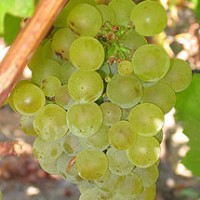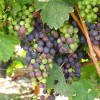With summertime just around the corner, and the oppressive heat soon to follow, my wine choices seem to change. Yes, I still grab for a big Shiraz or Cabernet with that grilled lamb or steak, but that is more in the evening and honestly not quite as often with the temperatures staying into the 90s after sundown. As my culinary choices shift to the lighter and more refreshing, my wine selections do as well. And recently, I have been drinking varying regions containing Sauvignon Blanc. If you have not had the pleasure of sampling a Sauvignon Blanc, then grab your car keys (after reading the rest of this story) and get to the wine shop.
Like many other grape varieties, Sauvignon Blanc has strong “roots” based in France. In 1968, French Sauvignon Blanc was the 13th most planted white variety rising to 3rd by the year 2000 (behind only Ugni Blanc and Chardonnay). This increase in plantings was largely in part due to the development of better suited clones and sprays to combat black rot and powdery mildew. Today we can find this variety in multiple regions throughout France and across the world.
This white grape variety, although successful in its own right, has also had a part to play with another variety. Along with Cabernet Franc, it is the parent to Cabernet Sauvignon, with which it shares an herbaceous quality. In addition to this descriptor, Sauvignon Blanc is also recognized as being grassy, green fruit (especially gooseberries) nettles, or blackcurrant leaves, and a classic description: “cat pee on a goose berry bush.” I know this doesn’t sound like anything appealing, and honestly I’ve never in my life smelled cat pee on a goose berry bush, but, trust me, this really is a great wine.
Some drawbacks to this variety are that the vine is particularly vigorous and if left unchecked can produce an excessively herbaceous and rank wine. Also, Sauvignon Blanc can taste oily when raised in too warm a climate and fails to develop the full aromatics reminiscent of its variety (may only have hints of peach). Most Sauvignon Blanc is meant to be drunk young although some with more oak need a couple of years in bottle to fully integrate. As they bottle age, they develop vegetal notes of asparagus and peas, which can be enjoyed by some. Personally, I like the youthful qualities of these wines.
If Chardonnay is the ruling white variety of Burgundy, then Sauvignon Blanc is truly home in Loire Valley, especially Central Vineyards. The wines of this area demonstrate a flinty characteristic and, like most French wines, are named for the area rather than variety. Such names as Sancerre (where it can be known as Blanc Fumé), Pouilly Fumé, and the western Satellites of Quincy, Reuilly, and Menetou-Salon can be recognized on the label. It has even spread further west into Touraine and even Anjou, where it is sometimes blended with Chenin Blanc.
Moving southwest to Bordeaux, we find Sauvignon Blanc in a dual role. In Entre du Mers and Graves it is similar to that of Loire with its crisp acidity but with less integrated complexity and steely minerality. For this reason, it is often blended with Sémillon to add body. On store shelves you can see this as Graves, Entre du Mers and even the Bordeaux AC label for a white wine. These wines are mostly, and sometimes completely, Sauvignon Blanc and usually represent a good value. On the other side of the coin, Sauvignon Blanc is a component of the sweet botrytis affected wines (blended with Sémillon and Muscadelle) found in areas of Sauternes, Barsac and Sainte Croix du Mont. The Sauvignon Blanc’s acidity is used to balance the sweetness of these unctuous and long-lived wines.
South West France shows examples of Sauvignon Blanc in Bergerac, Cotes du Marmandais, and Cotes de Duras. Even in the Mediterranean climate of southern France, Sauvignon Blanc emerges in the Vin de Pays areas of Languedoc-Roussillon and is even found in some Provençial appellations.
This grape, as do many others, has its history in France but has found a home making quality wine in many other parts of the world. Northern Italian areas of Friuli and Alto Adige express a more pungent example of Sauvignon Blanc. Imported into Spain many years ago, it has found success in Rueda and Torres. Even areas as far away as South Africa and Australia, especially in cooler areas such as Elgin and Darling, S.A. and Adelaide Hills, A.U., have produced some stellar examples.
In the New World, Sauvignon Blanc has made a home in California, where, in the 1980s, Robert Mondavi renamed the variety Fumé Blanc (designated oak aged) as a marketing venture. It caught on with a fever and Sauvignon Blanc was here to stay. In the warmer areas of California, these wines tend to be heavier on the palate compared to its old world expression. Washington State also makes both Sauvignon and Fumé Blanc, but with the cooler climate, it tends to be a compromise between the California and French wines. The New World area to watch is Chile. The Maule and Casablanca regions have started to have some impressive results with their Sauvignon Blanc.
Loire Valley aside, the Sauvignon Blanc variety has enjoyed some of its greatest success in New Zealand. This variety is credited with launching New Zealand into the spotlight of world wine culture. When New Zealand began planting Sauvignon Blanc, they had the benefits of climate, old world knowledge, and experimented with varying levels of barrel maturation and fermentation, picking at varying levels of ripeness, and canopy management styles. These “experiments” paid off with the country now being on the cutting edge of canopy management and creating a style of Sauvignon Blanc (herbaceous, pungent, acidic, aromas of capsicum, cut grass, elderflower, stony minerality, and sometimes hints of passion fruit) that even some French wineries now emulate.
These wines also make great partners with food, a quality I love in a wine. The type of Sauvignon Blanc, herbaceous and grassy or citric, determines the food pairings. A cooler climate Sauvignon Blanc goes well with sashimi, oysters, clams, light fish, chicken, and veal dishes. Where the more “grapefruity” and citrus forward wines are good with oily fishes, vegetal dishes like asparagus, tomatoes, onions, and feta cheese. Keep in mind, Sauvignon Blanc, with its high acid, does not play well with dishes filled with butter or cream. Try picturing a mixture of lemonade and milk. Of course, you could always just chill it down and enjoy it with nothing but a hot summer’s day. Enjoy!!



 Masters of Wine
Masters of Wine Wine and Spirits Education Trust
Wine and Spirits Education Trust